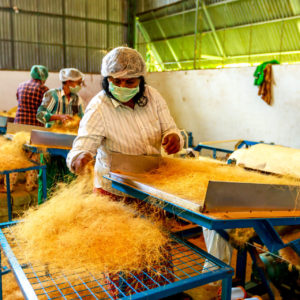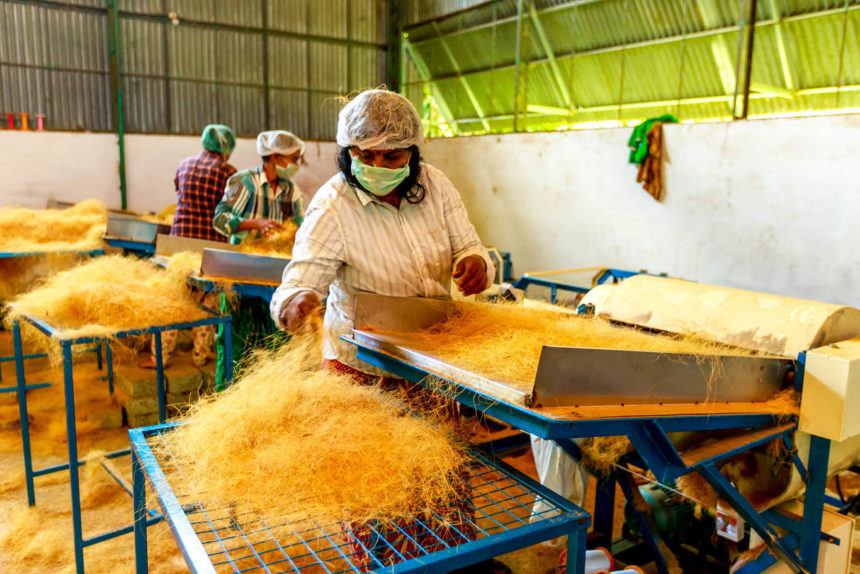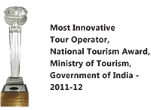Coir
Coir, the environment friendly yarn, spun of the natural fiber of Coconut husk, is the life line of villagers along the coast of Kerala – the land of Kera (Coconut), from time immemorial.
Blessed with salubrious weather and the interconnected network of rivers, lakes and lagoons running parallel to the coast, the land is fertile for coconut cultivation.
Husk of coconut is the raw material of the Coir, which is locally available throughout the coast of Kerala. Having 37% of the husks available in India, Kerala produces around 70% of Indian Coir and coir products.
Coir and coir products find direct use in cultivation, fishing, household and for the construction of houses and boats. Thanks to the abundance of high-yielding coconut trees and the superior quality of this organic fiber in terms of color, durability and flexibility, the Coir and the Coir products of Kerala have gained much demand in the global market.
Being an intermediate as well as final product, serving a variety of purposes, Coir has demand in the space of people of all walks of life, either as a utility material or as a decorative one. The finished coir products such as clinical mattresses, mats, carpets, baskets, ropes, geo-textiles and many more, have gained popularity in the modern society where an alternative to plastic products is of an urgent need.

Husk – the raw material
The husk of coconut is the thick layer of the fiber that covers the hard shell of its edible core. It is cheap, plenty and easily available throughout the coastal villages of Kerala. Since coconut is an inevitable ingredient of any cuisine of Kerala and an unavoidable requirement for daily rituals in temples, hundreds of thousands of coconuts must be de-husked on daily basis. The dry husk is used as an alternative to firewood.
From Husk to Coir products
 The people of the rural villagers in Kerala, especially of Kasaragod, Alleppey, Kollam and Trivandrum, are traditionally skilled at dehusking, retting, defibering and coir spinning and hand-loom weaving.
The people of the rural villagers in Kerala, especially of Kasaragod, Alleppey, Kollam and Trivandrum, are traditionally skilled at dehusking, retting, defibering and coir spinning and hand-loom weaving.
Retting is the procedure of soaking the husk for 6-10months in saline water, so as to loosen the thick pack of fibre, the strands to be fluffy, yellowish, resistant to rotting and pliable for spinning.
Traditionally defibering is done by beating and combing using indigenous methods. Spinning of coir yarn is done by twisting the fibre by hand. Handloom is used for weaving of the yarn to make mats and carpets and geo-blankets.
Coir industry in Kerala
Even though mechanisation of Coir manufacturing is progressing slowly, the traditional practices are still being continued, as the traditional workers of middle and elderly age group are still not convinced of its benefits. Rather they fear losing their livelihood. Majority of the workers engaged in the various stages of coir making belong to the socially and economically backward classes and among them majority is women.
 Even though Coir spinning is an occupation of antiquity, the manufacturing of Coir products on looms was introduced by the middle of 19th century by a trade representative of US, Mr. Durragh, the co-founder of M/S Durragh Smail company & Ltd. in Alleppey.
Even though Coir spinning is an occupation of antiquity, the manufacturing of Coir products on looms was introduced by the middle of 19th century by a trade representative of US, Mr. Durragh, the co-founder of M/S Durragh Smail company & Ltd. in Alleppey.
Subsequently many European companies started such units in Alleppey, with bigger looms, engaging the local workforce. Coir from across Kerala was brought to the Alleppey market for manufacturing various products considering the superior standard of the skill of the local people and the convenience of shipping from the port of Alleppey.
Today Alleppey Coir has a GI tag. Owning to the quality of the coir, the products from this region stand out in the domestic and international markets.
As the significance of the Alleppey port was lost due to the natural shifting of sand bar caused by geological reasons, and as the labour unrest against exploitation of the local workforce became intense, by the post-Independence period the European companies gave up their ownership, leaving behind their establishments and the machinery. The retrenched labourers who were compensated with the looms and machinery started small units in their own houses in and around Alleppey. Thus, the centralised prospering industry of the pre-independence era had disintegrated by the post-independence period and eventually evolved into a cottage industry. The villagers had with them the traditional know-how to sort, bleach and color coir at their houses and to weave a variety of coir products on heavy structured hand-looms, as per the orders they get from various sources.
However, the sustainability of the industry has always been inconsistent because of the erratic fluctuations for the demand in the foreign markets. Being export oriented every setback from the foreign market results in severe impact on the livelihood of the workers.
Sustainability through Co-operativisation
Protection of such a significant traditional industry being the social responsibility of the State, the Government has introduced co-operatives so as to intervene and gain control over the sustainability of the small units and household units scattered across the State. This initiative is enabling the State to ensure regular income and well-being of the workers and their families, preventing exploitation of the workers by middle-men and exporters and to get control over the quality of the produces. In order to attract more workforce to the industry and preserve the traditional skill, emphasis is given for research and development of new technology, improvisation of quality to compete with other types of yarns, to explore more areas for application of the fiber and the coir yarn, healthy working environment and decent income and welfare schemes for the workers.
These efforts taken through co-operativisation have proven to be effective in social and economic progress of the rural community, even though the present generation of workers are hesitant to let their new generation carry this traditional skill forward as the speculation about the sustainability of the industry is not convincing for them from the experience of their lifetime.
How does one learn the traditional art of making products using Coir?

RV Vaikundam offers an expedition form of cruising on the Backwaters of Kerala. RV Vaikundam is a 9 cabin (1 Deluxe Cabins and 8 Superior cabins) motor vessel offering a seven-night eight-day rendezvous, from October to April.
On day 2 of the 7 night North-South Cruise we visit the village spending time with the coir weavers, the shell harvesters and farmers, engaging in conversation with them about the riparian life, and watching various indigenous techniques of fishing. Coir, one of the major exports of Kerala, is of much relevance today than ever before when plastic has become a global menace. People of Chenganda are major suppliers of this cottage industry.
The 7 night North-South Itinerary starts at Kochi and ends in Alleppey in the State of Kerala, while the 7 night South-North Itinerary starts from Alleppey to Kochi in the State of Kerala. Airport connectivity is available at Kochi. All inclusive price starts from USD 250* per person per night for base category cabins. *Terms and conditions apply.
The Itinerary is subject to weather and river conditions or if we are faced with any political challenges. The tourism season is from October to April.

















Leave a Reply
You must be logged in to post a comment.